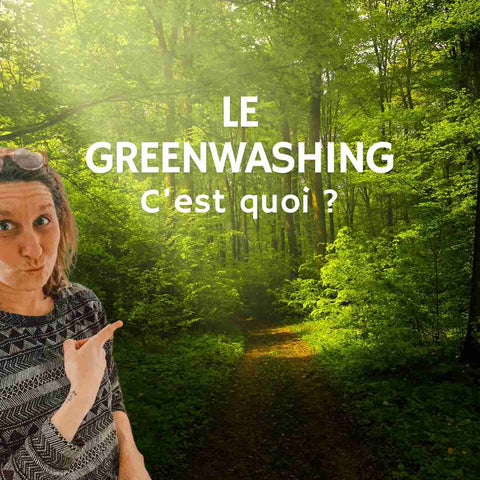Have you ever felt cheated into buying an eco-friendly product, only to find out later that it wasn't as eco-friendly as you were led to believe? This is where greenwashing comes in, a practice which consists of giving a misleading ecological image to a product or a company in order to attract consumers. But don't worry, we're going to dive into the world of greenwashing and I'll provide you with the tools you need to detect it.
What is greenwashing?
Greenwashing , literally “green washing” in French, is a marketing strategy used by companies to present themselves as environmentally friendly, when in reality, they are not necessarily so. It is as if the latter wore a false “green” label, hiding prohibited practices behind a misleading name.
Common Examples of Greenwashing
TV commercials: You've probably seen those commercials where a company brags about its green initiatives, but in reality, they only represent a tiny part of their actual business.
“Green” packaging: Some products have green packaging or “eco” labels, but that doesn’t always mean they are actually eco-friendly.
The Fake “Made in France” : Some products include the French flag to make people believe they are made in France, when only the brand is French and the product is manufactured far away.
Greenwashing techniques
Greenwashing by association: A company may attempt to give itself an ecological image by associating its product with popular environmental causes, without actually contributing to these causes, as is the case for large soda brands.
Misleading words and images: The use of terms like “natural”, “eco-friendly” or even images of nature on packaging can be used to mislead consumers. The same goes for the term “biodegradable” or “100% recycled” which is often false.
Environmental impact
Greenwashing can have a detrimental impact on the environment in several ways. By encouraging consumers to purchase products that are not truly environmentally friendly, it contributes to overconsumption and waste of natural resources.
Deception about the origin is also harmful to the environment, because the carbon footprint of the product is less than we believe and therefore more polluting.
How to spot greenwashing?
Do your research: Don't just rely on the company's claims. Do independent research to verify its environmental claims. For example, we sometimes do not have the industry necessary to make insulated bottles in France, so an insulated bottle can be printed or packaged in France, but the product will necessarily come from elsewhere! The price is also an indicator, a new dress for €20 cannot cover the manufacturing costs (labor, material, margin and taxes) in France or even in Italy!
Analyze the evidence: Ask yourself if the company provides concrete evidence of its commitment to the environment, such as certifications or sustainability reports.
Consequences of greenwashing
Loss of trust: When consumers realize they have been deceived by greenwashing , it can lead to a loss of trust both in the company involved and in environmental efforts in general.
At My Better Way, I try to highlight made in France as much as possible; if the product is made elsewhere, I mention it on the product sheet and explain why I chose to promote it. this product.
Unfortunately, I am in competition with less scrupulous brands who sell products made in China at a very low price, passing them off as a good French deal... and I therefore cannot compete! This is unfair competition and false advertising!
Consumer responsibility
As consumers, we also have a role to play in the fight against greenwashing . By being vigilant and choosing to support businesses that are truly committed to the environment, we can encourage positive change in business behavior.
By choosing French manufacturing, even more expensive, we support our economy, our industry, and we retain purchasing power in the country, for our taxes, our public service and our pensions.
If we support Made In China, we send our money outside the country to contribute to the enrichment of China.
Fight against greenwashing
Transparency: Companies must be transparent about their practices and their impacts on the environment, in order to avoid any accusations of greenwashing .
Regulation: Governments can play a role by putting in place stricter regulations to govern companies' environmental claims and punish greenwashing.
Conclusion
In conclusion, greenwashing is a deceptive practice that can have harmful consequences on the environment and consumer confidence. It is essential to remain vigilant and use discernment when making your purchases to avoid falling into the trap of greenwashing!
FAQs
1. What are the risks of greenwashing for the environment?
Greenwashing can encourage overconsumption and waste of natural resources by encouraging consumers to purchase products that are not actually environmentally friendly.
2. How can companies be more transparent in their environmental practices?
Companies can be more transparent by providing tangible evidence of their environmental initiatives, such as certifications or verifiable sustainability reports.
3. What is the role of governments in the fight against greenwashing?
Governments can play a role by putting in place stricter regulations to govern companies' environmental claims and by punishing greenwashing practices.
4. Are products with “eco” labels still environmentally friendly?
Unfortunately, this is not always the case. It is important to use your best judgment and check the environmental claims of products before purchasing them.
5. How can I help fight greenwashing as a consumer?
As a consumer, you can help fight greenwashing by being vigilant, researching companies before purchasing their products, and supporting those who are truly committed to the environment.



